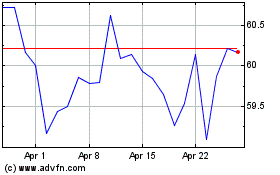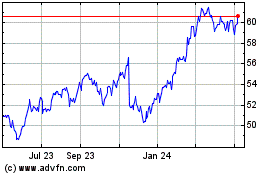Battle of Behemoths Turns Up a Notch -- WSJ
June 17 2017 - 3:02AM
Dow Jones News
By Sarah Nassauer and Imani Moise
Amazon.com Inc.'s purchase of Whole Foods Market Inc. isn't just
a $13.7 billion bet that many shoppers still want to buy groceries
at physical stores. It is a direct strike at the world's biggest
retailer: Wal-Mart Stores Inc.
Wal-Mart generates more than half of its $486 billion in annual
revenue from groceries and is the country's largest grocer.
Shoppers' penchant for picking their own produce and the
unprofitable nature of delivering fresh food to homes has given
Wal-Mart a rare edge over Amazon and breathing room while ramping
up its digital business with a string of e-commerce acquisitions
and other investments.
"I feel great about how we are positioned with 4,700 stores,"
Wal-Mart's e-commerce chief Marc Lore said Friday in an interview.
"It's fun playing offense and I like the fact that we aren't
chasing."
That edge may narrow for Wal-Mart and other retailers who have
relied on a grocery advantage. In the wake of Amazon's acquisition,
Wal-Mart shares fell 4.7% in Friday afternoon trading. Costco
Wholesale Corp. dropped 6% while Kroger Co. slid 11.6%.
"This deal just accelerates where we thought the world was going
with Wal-Mart and Amazon fighting over price, assortment, and
convenience as titans for the next decade," said Brandon Fletcher,
retail analyst at Bernstein in a research note.
On Friday morning, five minutes after Amazon's mega-deal was
announced, Wal-Mart said it completed another small web purchase:
It said it was paying $310 million for online menswear retailer
Bonobos, known for its $98 chinos. The purchase gives Wal-Mart
access to a brand that exists primarily online for the first time,
said Mr. Lore, as well as talent. Bonobos founder, Andy Dunn, will
head Wal-Mart's efforts to build online, direct-to-consumer
brands.
It is the fourth small e-commerce acquisition for Wal-Mart this
year and the latest salvo between the behemoths.
The rivalry heated up last fall as Wal-Mart bought Mr. Lore's
startup Jet.com for $3.3 billion and put him in charge of its
e-commerce operations. Mr. Lore, who had sold a previous startup to
Amazon, vowed to use his Wal-Mart perch to take on Amazon.
Mr. Lore has since engineered a series of small acquisitions,
adding niche online chains that appeal to wealthier or more
fashion-forward shoppers than Wal-Mart's core customer such as
Moosejaw and Modcloth. Wal-Mart has also ramped up efforts to use
its stores to ship online orders. It is also expanding its online
grocery pickup service to around a thousand stores and testing
using store workers to deliver online orders on their way home from
work.
Earlier this month Amazon took direct aim at Wal-Mart by
discounting its Prime membership program for shoppers on government
assistance, a core Wal-Mart cohort.
Wal-Mart executives have repeatedly cited their massive U.S
store base as an advantage over Amazon. "Will it be easier for an
e-commerce company to build out a massive store network and create
a customer service culture at scale? Or are we better able to add
digital and supply chain capabilities and leverage our existing
stores?" Chief Executive Doug McMillon told investors in 2015. At
the time, Wal-Mart discussed a plan to invest billions of dollars
in online operations and stores, triggering a steep selloff in
stock.
Since then Wal-Mart has put particular focus on improving the
quality and selection of fresh produce and meat, adding new
lighting and more organic food to the section, in part because
those items are primarily bought in stores.
Only around 9% of households who shopped at Whole Foods in April
also shopped at a Wal-Mart, according to data from Kantar Retail.
"Outside of Texas, there just aren't that many areas that matter to
Wal-Mart's grocery business that also matter to Whole Foods," said
Bryan Gildenberg, analyst at Kantar. Still, Amazon could bring
Whole Foods "to a much larger audience" over time, he said.
Wal-Mart's digital push is an extreme departure from its
historical model of building hundreds of new stores each year to
grow sales. The shift has ruffled some feathers internally and
externally, say people familiar with the situation. Billionaire
Warren Buffett sold off the majority of his long-held Wal-Mart
stock in the wake of the shift.
Write to Sarah Nassauer at sarah.nassauer@wsj.com and Imani
Moise at imani.moise@wsj.com
(END) Dow Jones Newswires
June 17, 2017 02:47 ET (06:47 GMT)
Copyright (c) 2017 Dow Jones & Company, Inc.
Walmart (NYSE:WMT)
Historical Stock Chart
From Mar 2024 to Apr 2024

Walmart (NYSE:WMT)
Historical Stock Chart
From Apr 2023 to Apr 2024
